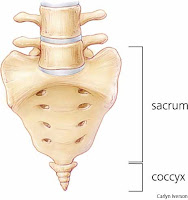Tailbone (coccyx) pain, also known as coccydynia/coccygalgia/coccygeal, presents as severe localized pain in the tailbone/coccyx area. Pain is usually associated with the sitting position, defecation, coughing, standing, walking, bending forward, and the movement from sit to stand. Pain begins or increases after a long bout of sitting, direct injury from a fall or sport’s trauma, and after pregnancy, labor and delivery.
There can be many other causes for pain felt in the tailbone area. The low back and the sacroiliac joint can be involved in or the cause of pain in the tailbone. Also factures, tumors, infection, inflammation in the pelvis can be associated with tailbone pain. Certain psychosomatic disorders can cause pain in the pelvis or buttock muscles.
If experiencing these symptoms, first see a primary care physician to rule out medical issues, such as infection/inflammation, tumors, and fractures. Afterwards you can ask for a physical therapy referral. A physical therapist will want to first rule out if the pain is caused by the low back, pelvis or hips. A physical therapist specialized in coccydynia can use several techniques to decrease pain, improve sitting posture and address muscle weakness or imbalances.
http://www.womenshealthapta.org/find-a-physical-therapist/index.cfm
http://www.womenshealthapta.org/find-a-physical-therapist/index.cfm
There are a couple things you can try on your own that may help your pain before seeing a physician or physical therapist. First, DO NOT use a hemorrhoid/ring pillow; this can make the pain worse. You can use ice around the area, with couple towels between the ice and you to protect the skin; do not use ice for more than 10 minutes at a time. Place a low back pillow or support in a chair and sit with good posture and positioning, and try not to sit for more than 30 minutes continuously. These techniques can be used to minimize symptoms, but if the pain continues to persist, be sure to contact your physician or a local physical therapist.
http://www.apta.org/apta/findapt/index.aspx?navID=10737422525
Special Topics in Pregnancy and Postpartum.Chicago , Illinois Chicago
http://images.search.yahoo.com/images/view;_ylt=A2KJkIfgKdVOMlkAIrqJzbkF;_ylu=X3oDMTBlMTQ4cGxyBHNlYwNzcgRzbGsDaW1n?back=http%3A%2F%2Fimages.search.yahoo.com%2Fsearch%2Fimages%3Fp%3Dcoccyx%26n%3D30%26ei%3Dutf-8%26y%3DSearch%2BImages%26b%3D1%26tab%3Dorganic&w=463&h=492&imgurl=images.yourdictionary.com%2Fimages%2Fmain%2FA4coccyx.jpg&rurl=http%3A%2F%2Fimages.yourdictionary.com%2Fcoccyx&size=15.7+KB&name=coccyx+-+Images&p=coccyx&oid=91b1ac6908932f5d7fb071a0f7d77f5d&fr2=&fr=&tt=coccyx+-+Images&b=0&ni=30&no=0&tab=organic&ts=&sigr=117cahi83&sigb=1337jbukb&sigi=11i0tjrmt&.crumb=wwdsm/045AV
Accessed by Cheryl Lynn Rudd November 29, 2011
http://www.apta.org/apta/findapt/index.aspx?navID=10737422525
Special Topics in Pregnancy and Postpartum.
http://images.search.yahoo.com/images/view;_ylt=A2KJkIfgKdVOMlkAIrqJzbkF;_ylu=X3oDMTBlMTQ4cGxyBHNlYwNzcgRzbGsDaW1n?back=http%3A%2F%2Fimages.search.yahoo.com%2Fsearch%2Fimages%3Fp%3Dcoccyx%26n%3D30%26ei%3Dutf-8%26y%3DSearch%2BImages%26b%3D1%26tab%3Dorganic&w=463&h=492&imgurl=images.yourdictionary.com%2Fimages%2Fmain%2FA4coccyx.jpg&rurl=http%3A%2F%2Fimages.yourdictionary.com%2Fcoccyx&size=15.7+KB&name=coccyx+-+Images&p=coccyx&oid=91b1ac6908932f5d7fb071a0f7d77f5d&fr2=&fr=&tt=coccyx+-+Images&b=0&ni=30&no=0&tab=organic&ts=&sigr=117cahi83&sigb=1337jbukb&sigi=11i0tjrmt&.crumb=wwdsm/045AV
Accessed by Cheryl Lynn Rudd November 29, 2011

Hello!
ReplyDeleteThank you so much for discussing about tailbone pain, it is very helpful and useful for.Thanks again!